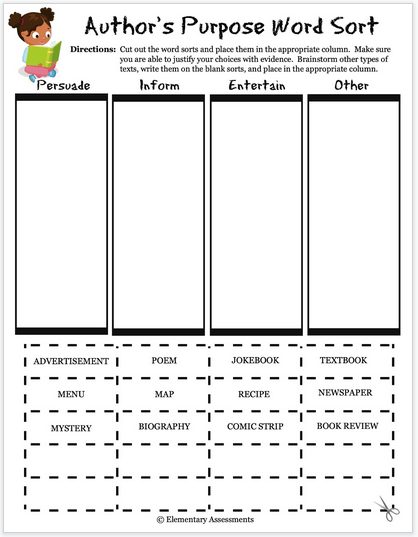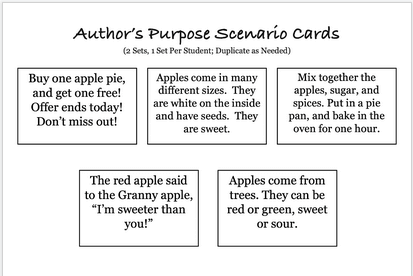Here you will find a variety of engaging author’s purpose activities.
The ability to analyze an author’s purpose is a useful skill that students will utilize for the rest of their lives.
When we watch tv shows, read magazines, enjoy movies, glance at billboards, scan a menu, or read a recipe book, the author or creator of these mediums is always sending us a message – whether we realize it or not.
He is trying to encourage the reader to take some sort of action, think a certain way, or absorb some type of information that he feels the reader should know.
While communicating a message to readers isn’t inherently a bad thing, some authors do try to negatively change/control people’s mindset, beliefs, or the type of information they consume.
That’s why it’s essential to teach students about an author’s purpose and the significant influence authors have on readers.
Exposing students to a variety of author’s purpose activities will help them analyze and comprehend what message the author is sending in addition to why.
The following author’s purpose activities help students move beyond PIE and encourage higher-order thinking.
Author’s Purpose Activities
1. Host a Debate.
Debates are exciting for students.
Debates are fantastic for developing students’ critical thinking skills, opening their minds to various viewpoints, and investigating alternative ideas.
They are not arguments but responsible and respectful dialogues that broaden perspectives.

Here’s how to use author’s purpose debate cards…
- Divide students into groups: half of class vs. other half, partner vs. partner, or teacher vs. class/group (the latter option great for modeling)
- Select a debate card topic.
- Each group takes some time to research and take note of the various viewpoints regarding the issue. (Research can be facts and/or personal experiences.)
- Then each team takes a stance on the subject at hand, defending its position to the other group.
- One of two options will result: participants will reshape their opinion based on new knowledge or their point of view on the topic will strengthen.
2. Categorize Using Word Sorts.
Word sorts increase students’ comprehension of related vocabulary words by having learners categorize an assortment of pre-selected terms.

Here’s how the author’s purpose word sorts activity works…
- Students cut out the word sorts, and place them in the appropriate column (either persuade, inform, entertain, or other).
- The word sorts activity page includes blank sorts. Students brainstorm additional types of texts, record them on the blank sorts, and then place in the appropriate column.
- Afterwards, they justify their category choices with evidence.
3. Brainstorm With Thinkmarks.
During your author’s purpose unit, students will analyze lots of different books.
It’s easy for them to fall into the habit of using the same three terms repeatedly when discussing the author’s purpose: persuade, inform, and entertain.
To support their efforts in utilizing synonyms, provide author’s purpose bookmarks (also known as thinkmarks).

4. Go On An Author’s Purpose Scavenger Hunt.
- Distribute an author’s purpose scavenger hunt graphic organizer to each learner.
- In pairs, students hunt for various types of text. These text selections come from the classroom library, school library, environmental print, etc.
- As they choose and analyze texts, they fill in the graphic organizer with the appropriate information: title of book (first column), author’s purpose (second column), and evidence from text to support reasons (third column).

5. Match the Scenarios.
Project onto a screen or distribute to each student a copy of the author’s purpose pie chart graphic organizer along with a set of the accompanying scenario cards (see image below).
Here’s how to teach Match the Scenarios author’s purpose activity…
- Review with students the primary reasons an author writes: to persuade, to inform, to entertain, to explain, and to describe.
- One-by-one, read with students each scenario card, discussing the evidence that supports the author’s purpose of that particular card.
- Afterwards, learners place the card in the correct blank square on their individual pie chart.
6. Perform An Author’s Purpose Reader’s Theater.
Readers’ theaters present a fun way for students to enrich their understanding of various concepts, including author’s purpose!
Use this author’s purpose readers’ theater script as a center activity, partner read, or as a text during Readers’ Workshop to tackle other reading objectives as well.

7. Complete Reading Passages.
Reading comprehension passages fit well as one of your author’s purpose activities because they are low-prep and prompt students to apply their knowledge.
Choose reading passages from a variety of genres so that students will have an opportunity to analyze the author’s purpose from different types of texts.
8. Utilize Author’s Purpose Task Cards.
Author’s purpose task cards provide a great alternative to worksheets.
9. Respond to Author’s Purpose Writing Prompts.
This is one of the author’s purpose activities that integrates seamlessly with writer’s workshop.
Simply give students a prompt or sentence starter that ask them to persuade, entertain, or inform.

10. Review Mini Author’s Purpose Anchor Charts.
Snap a picture of a completed author’s purpose anchor charts, download them, and then make photocopies for each student.
Students then paste these mini anchor charts into their reader’s and/or writer’s notebook.
They refer to them as they complete author’s purpose activities.

11. Create An Author’s Purpose 4-Column Chart.
Divide an author’s purpose anchor chart into four columns: persuade, inform, entertain, and other.
Place it in a visible and accessible place in the classroom.
Throughout the year, students add titles of read aloud texts along with examples of evidence that support the author’s purpose.
Final Thoughts
These author’s purpose activities equip students with the reasoning skills necessary to understand and analyze an author’s message.
Additionally, these tasks develop students’ ability to make sound judgments about certain topics.
Download these author’s purpose activities for free for a limited time via Google Slides! (You need to first log into your Google account before you’ll be able to make a copy.)


